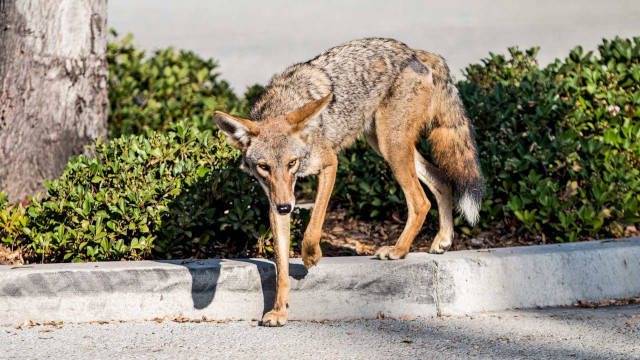Urban coyotes are present in practically every city across the United States. For many cities and suburbs, dealing with urban coyotes is a new concept. Coyotes—which were often heard in these areas but rarely seen—are now making themselves very visible.

There is still much to learn about how coyotes use urban environments. We do know that coyotes have learned to thrive in urban settings, in large part due to the availability of food and the lack of natural predators. This has led to an increase in the coyote population, resulting in more encounters between man and animal. Unlike rural coyotes, their urban counterparts have a longer lifespan and tend to live in larger groups.
Learn About Them
Before we can understand how to deal with the coyote, we need to know how to identify them. Coyotes and domesticated dogs are from the same family. They share a resemblance, especially from a distance, so it is important to tell them apart.
The coyote is generally a slender animal, very similar in appearance to a medium-sized dog. An adult coyote stands about two feet tall and is between 40 to 50 inches in length. Male coyotes are larger than females, and they can weigh anywhere from 20 to 50 pounds. The majority of coyotes are gray, although some may be a rusty, brown or off-white color.
The coyote is nocturnal, typically active after dark. However, a coyote that feels comfortable in and around an urban area and with its human inhabitants will move and hunt during the day.
Dealing With Urban Coyotes
For homeowners and residents of urban areas, it is essential to learn about coyote behavior and how to deal with coyotes in an urban setting. Only when we understand the “do’s and don’ts” of dealing with urban coyotes will we be able to coexist in relative peace.
Never Run Away From a Coyote! Turning your back and running from a coyote will trigger his predatory instincts. He may see you as prey, pursue, and attack.
Don’t Feed An Urban Coyote. In most recorded attacks by coyote on humans, it was found that the coyote was being fed by people. This, as with feeding other wildlife species, will cause the coyote to lose his natural fear of humans.
Don’t Attempt to Save Your Dog or Cat. If your dog or cat is attacked by a coyote, do not try to jump into the fight and save your pet. The coyote may consider you a competitor for the “food” and turn his aggression on you. In addition, urban coyotes do often hunt in loose groups. One coyote attacking you can very easily turn into a group of them attacking you.
Don’t Treat Coyotes as a Danger. They are a wild animal, as with any other wild animal. Learn to respect them, and teach them to respect your property boundaries with behavioral modification techniques. Coyotes will—under normal circumstances—keep their distance if you keep yours.
Do Carry Pepper Spray or an Airhorn When Walking Your Dog in Wooded Areas. If a coyote decides your small dog is on the menu, both pepper spray and a loud noisemaker (such as an airhorn) are effective at changing its mind. If you carry a walking stick, wave it aggressively while yelling at the coyote. Do not turn your back on the animal to walk away. Force the coyote to retreat, instead. Once it does, leave the area with your dog immediately.
Do Haze A Coyote On Your Property. The simplest method of hazing a coyote involves being loud and appearing large. Yell “GO AWAY COYOTE!” as you raise your arms above your head and wave them aggressively. Take steps towards the coyote if necessary, but don’t get so close as to corner the animal. Repeat this every time the coyote enters your property and it will help to modify its behavior. Eventually, it will learn that your property is a “no go” area.
Do Give A Coyote Space To Leave. When you find yourself in a starring contest with a coyote, do not take any actions that make the coyote feel cornered. This may cause the animal to feel forced to attack. Give it all the room it needs to leave the area.
Finally, keep in mind that if you walk up to and startle a coyote, and it turns aggressive, you may have just walked up to a coyote with its young nearby. When walking through parks and nature preserves stick to the marked trails, and make your presence known as you walk.
Although hazing can teach coyotes to keep their distance, there are situations when the best choice is to do nothing. If a coyote is off in the distance, and not bothering you or your pets, leave it be. Just appreciate it as part of nature. The coyote is a natural and resilient survivor, and odds are it is here to stay. We need to adapt to their presence, not the other way around.





